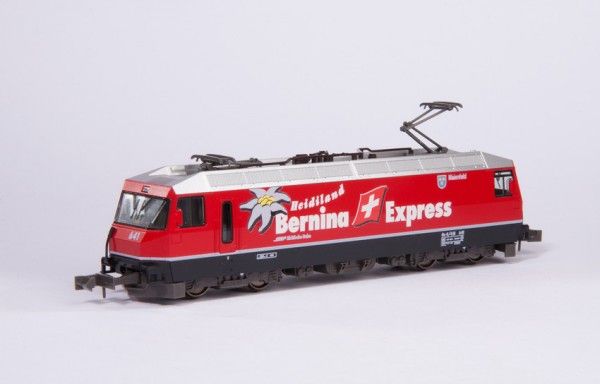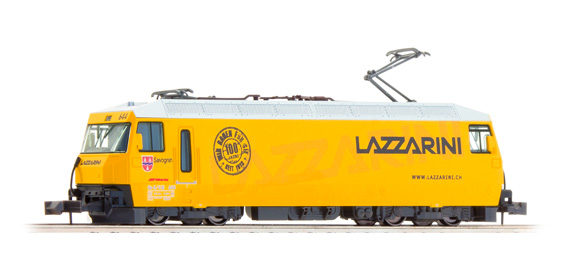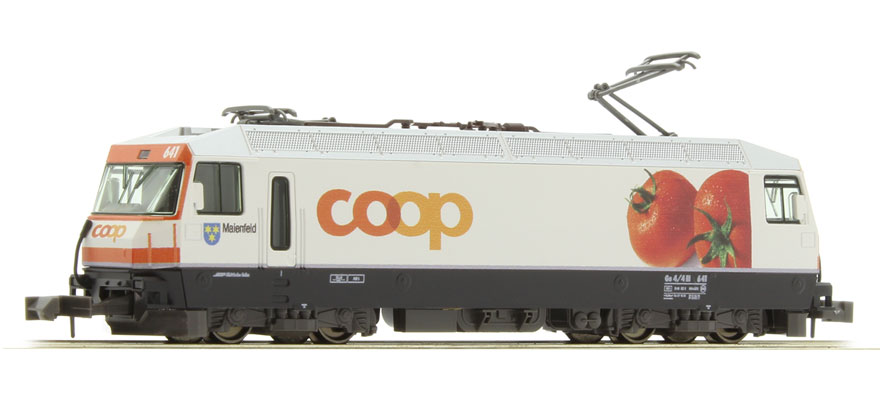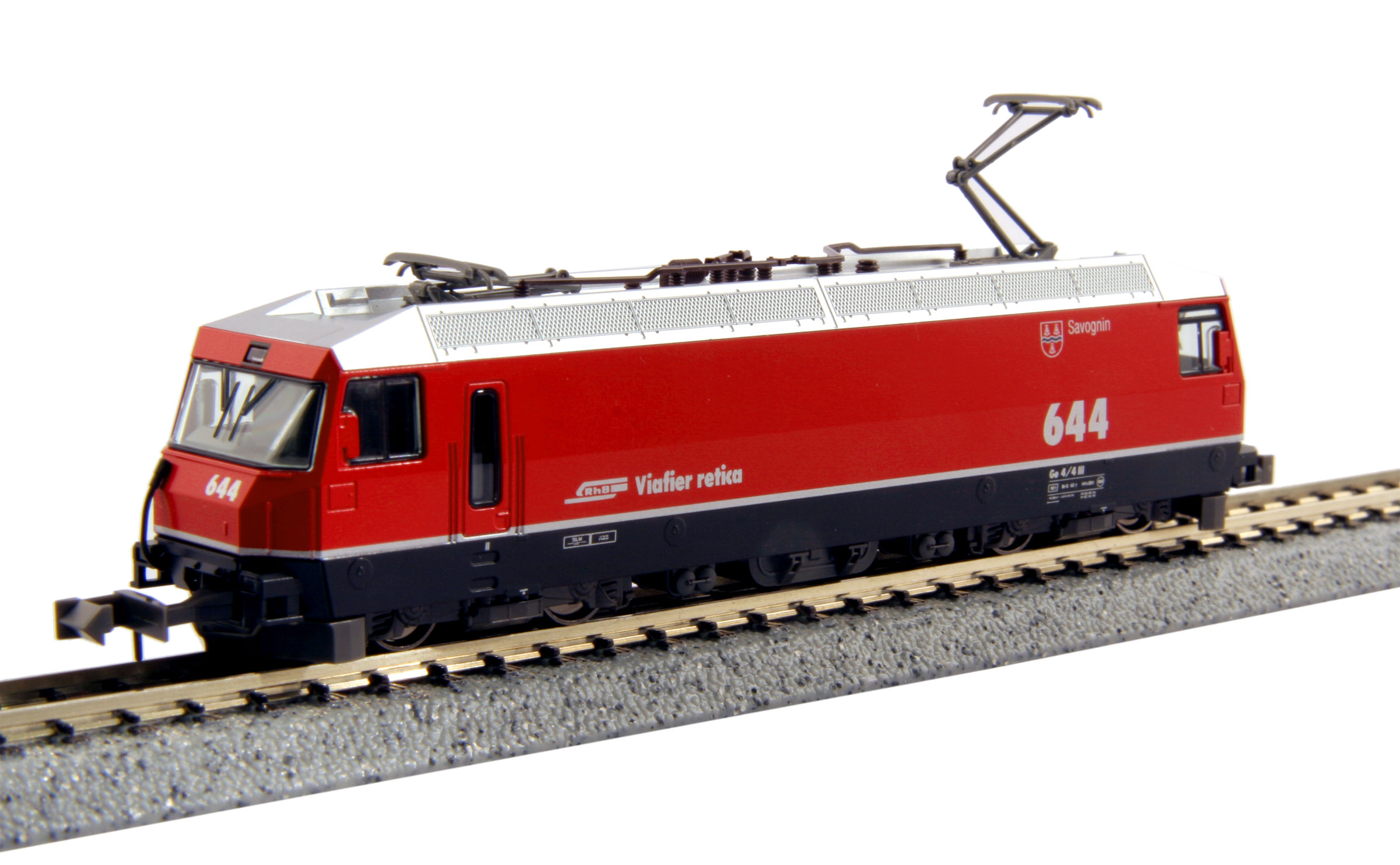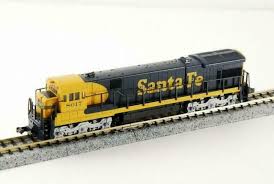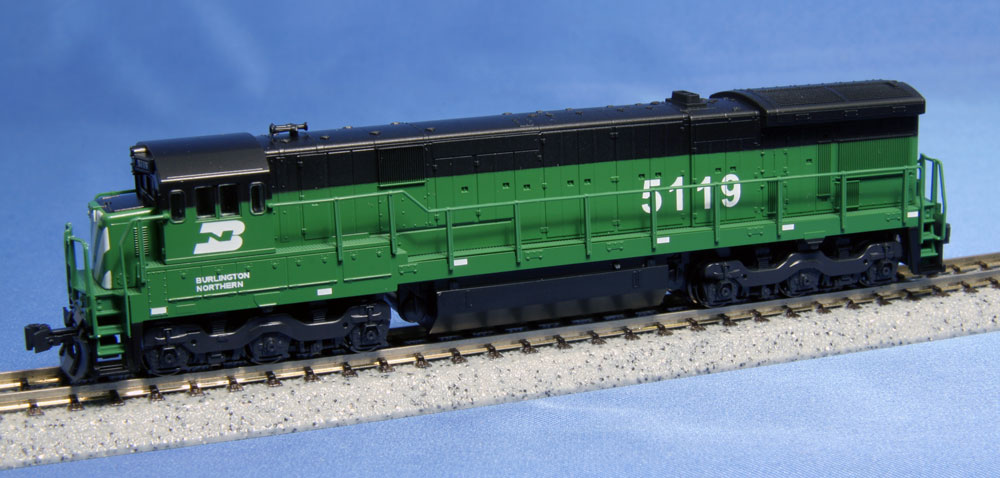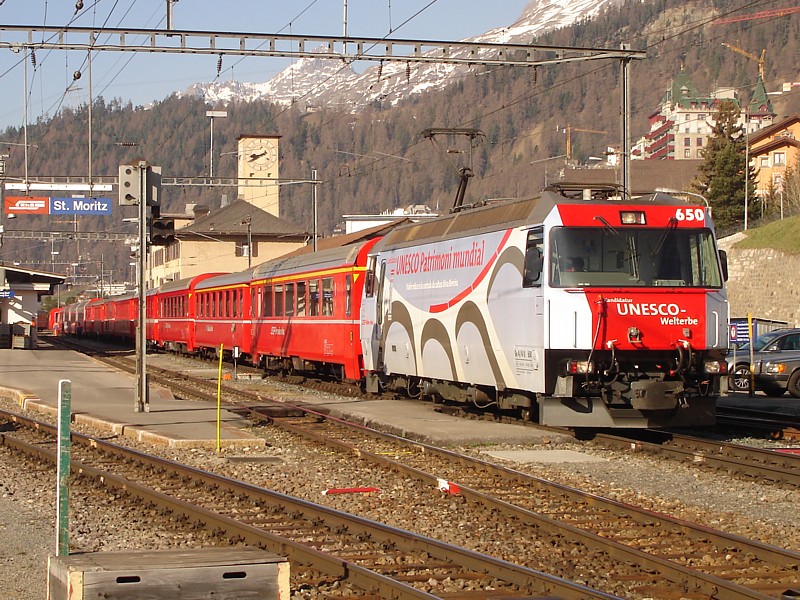Model Information: Model features:
- Smooth rolling Kato trucks with all wheel electrical pickup.
- Directional headlights.
- Optimized truck rotation on both locomotive and cars to allow the trains to go around a minimum R150mm (approx. 6") radius.
- The Ge4/4-III can pull the train up a maximum 5% incline.
DCC Information: This engine accepts the following drop-in decoders:
- Digitrax DN163K4A: 1.25 Amp N Scale Board Replacement Decoder for Kato N Scale Glacier Express and 4-8-4 FEF Steam Locomotive.
- TCS K7D4: 4 Function Drop-In for Kato ACS-64, EMD SPD40F, Ge 4/4 II and III "Glacier Express".
Adding a wired decoder is also possible and only requires modifications to the analog printed-circuit board; An example is shown on the 1zu160 website (in German).
- Digitrax DN163K4A: 1.25 Amp N Scale Board Replacement Decoder for Kato N Scale Glacier Express and 4-8-4 FEF Steam Locomotive.
- TCS K7D4: 4 Function Drop-In for Kato ACS-64, EMD SPD40F, Ge 4/4 II and III "Glacier Express".
Adding a wired decoder is also possible and only requires modifications to the analog printed-circuit board; An example is shown on the 1zu160 website (in German).
Prototype History: In order to manage the sharp increase in traffic on its network after the opening of the Vereina Tunnel, the Rhaetian Railway joined in 1989 with Swiss Locomotive and Machine Works and ASEA Brown Boveri, to develop a new generation of electric locomotives, the drive train of which was to be based upon AC technology with GTO Thyristors. The original plan for a six axle variant of the Ge 4/4 II, which would have had benefits on the nearly straight section of line through the tunnel, was rejected, in favour of a universally deployable locomotive with four axles, which could also be used on sections with tight radius curves. The result was the Ge 4/4 III class.
On 7 December 1993, the first Ge 4/4 III machine, no 641, was officially put into service. Between 1994 and 1999, eleven further locomotives followed, in three series, and were given numbers 642 to 652. The first of these further orders, made in 1989, consisted of six locomotives, and the second further order, in 1990, was for three. The third, placed with Adtranz in 1996, was intended to cover the additional demand due to the opening of the Vereina Tunnel, and was for another three machines.
The Ge 4/4 IIIs are now found at the head of almost all of the train sets on the Albula Railway, and they are the only locomotives used to haul car trains through the Vereina Tunnel. All of the locomotives in the class are currently decorated with colourful advertising liveries.
From Wikipedia
On 7 December 1993, the first Ge 4/4 III machine, no 641, was officially put into service. Between 1994 and 1999, eleven further locomotives followed, in three series, and were given numbers 642 to 652. The first of these further orders, made in 1989, consisted of six locomotives, and the second further order, in 1990, was for three. The third, placed with Adtranz in 1996, was intended to cover the additional demand due to the opening of the Vereina Tunnel, and was for another three machines.
The Ge 4/4 IIIs are now found at the head of almost all of the train sets on the Albula Railway, and they are the only locomotives used to haul car trains through the Vereina Tunnel. All of the locomotives in the class are currently decorated with colourful advertising liveries.
From Wikipedia
Road Name History: The Rhaetian Railway (German: Rhätische Bahn, Italian: Ferrovia Retica, Romansh: Viafier Retica), abbreviated RhB, is a Swiss transport company that owns the largest network of all private railway operators in Switzerland. The RhB operates all the railway lines of the Swiss Canton of Graub?nden/Grisons, except for the line from Sargans to the cantonal capital, Chur, which are operated by the Swiss Federal Railways (SBB CFF FFS), and the line from Disentis/Must?r to the Oberalp Pass, and further on to Andermatt, Uri, which is operated by Matterhorn-Gotthard-Bahn (MGB). Inaugurated in 1888 and expanded from 1896 onwards in various sections, the RhB network is located almost entirely within Graub?nden, with one station across the Italian border at Tirano.
The Rhaetian Railway serves a number of major tourist destinations, such as St Moritz and Davos. One of the RhB lines, the Bernina Railway, crosses the Bernina Pass at 2,253 metres (7,392 ft) above sea level and connects with the Italian railway network at Tirano, Lombardy.
In 2008, the RhB section from the Albula/Bernina area (the part from Thusis to Tirano, including St Moritz) was added to the list of UNESCO World Heritage Sites. The Albula-Bernina line is the first rail line in the world to be photographed and put on Google Street View.
From Wikipedia
The Rhaetian Railway serves a number of major tourist destinations, such as St Moritz and Davos. One of the RhB lines, the Bernina Railway, crosses the Bernina Pass at 2,253 metres (7,392 ft) above sea level and connects with the Italian railway network at Tirano, Lombardy.
In 2008, the RhB section from the Albula/Bernina area (the part from Thusis to Tirano, including St Moritz) was added to the list of UNESCO World Heritage Sites. The Albula-Bernina line is the first rail line in the world to be photographed and put on Google Street View.
From Wikipedia
Brand/Importer Information: Kato Precision Railroad Models (関水金属株式会社 Sekisui Kinzoku Kabushikigaisha) is a Japanese manufacturer of model railroad equipment in N and HO scales. The Tokyo-based company manufactures models based on Japanese prototypes (such as the Shinkansen bullet train) for the Japanese market, North American prototypes for the North American market and European high-speed trains for European market.
The Kato (pronounced kah-toe) model railroad companies were founded by Yuji Kato, father of current president Hiroshi Kato, of the parent company Sekisui Kinzoku Co., Ltd.
The design and distribution of models for the North American market are handled by their U.S. subsidiary, Kato USA, located in Schaumburg, Illinois.
The design of special models for the European market is handled for some of them by their partner, Lemke, whereas the general distribution of Kato products in Europe is handled by NOCH; both companies are located in Germany.
As a result, some Kato European models are sold as Kato Lemke and others as Kato (alone).
The Kato (pronounced kah-toe) model railroad companies were founded by Yuji Kato, father of current president Hiroshi Kato, of the parent company Sekisui Kinzoku Co., Ltd.
The design and distribution of models for the North American market are handled by their U.S. subsidiary, Kato USA, located in Schaumburg, Illinois.
The design of special models for the European market is handled for some of them by their partner, Lemke, whereas the general distribution of Kato products in Europe is handled by NOCH; both companies are located in Germany.
As a result, some Kato European models are sold as Kato Lemke and others as Kato (alone).
Commissioner Information: 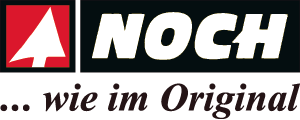 NOCH was founded 1911 in Glauchau (Saxony, Germany) by Oswald Noch, the great-grandfather of the current Managing Director. NOCH offer more than 1.500 products for model building enthusiasts: terrain building, track construction, bridges and viaducts, portals, walls and arcades, scenery modelling with treees and bushes, structures, figures, vehicles and decoration items as well as model railway layouts.
NOCH was founded 1911 in Glauchau (Saxony, Germany) by Oswald Noch, the great-grandfather of the current Managing Director. NOCH offer more than 1.500 products for model building enthusiasts: terrain building, track construction, bridges and viaducts, portals, walls and arcades, scenery modelling with treees and bushes, structures, figures, vehicles and decoration items as well as model railway layouts.
NOCH is also the European importer for Rokuhan, Kato and Athearn.
 NOCH was founded 1911 in Glauchau (Saxony, Germany) by Oswald Noch, the great-grandfather of the current Managing Director. NOCH offer more than 1.500 products for model building enthusiasts: terrain building, track construction, bridges and viaducts, portals, walls and arcades, scenery modelling with treees and bushes, structures, figures, vehicles and decoration items as well as model railway layouts.
NOCH was founded 1911 in Glauchau (Saxony, Germany) by Oswald Noch, the great-grandfather of the current Managing Director. NOCH offer more than 1.500 products for model building enthusiasts: terrain building, track construction, bridges and viaducts, portals, walls and arcades, scenery modelling with treees and bushes, structures, figures, vehicles and decoration items as well as model railway layouts.
NOCH is also the European importer for Rokuhan, Kato and Athearn.
Item created by: gdm on 2017-01-06 17:26:31. Last edited by CNW400 on 2020-06-15 16:39:14
If you see errors or missing data in this entry, please feel free to log in and edit it. Anyone with a Gmail account can log in instantly.
If you see errors or missing data in this entry, please feel free to log in and edit it. Anyone with a Gmail account can log in instantly.


